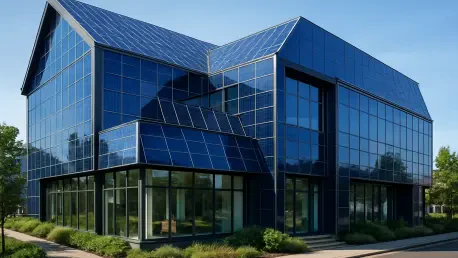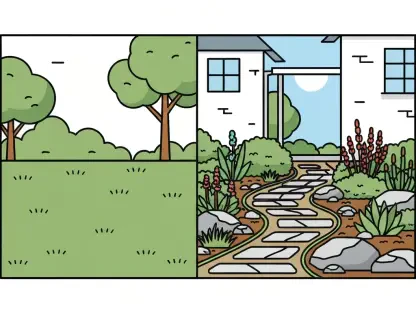In an era where sustainable energy solutions are no longer just an option but a necessity, the Building-Integrated Photovoltaics (BIPV) Solar Modules Market is experiencing a remarkable surge, posting an impressive Compound Annual Growth Rate (CAGR) of 12.11%. This cutting-edge technology seamlessly embeds solar panels into building components such as roofs, facades, and windows, merging energy generation with architectural elegance. As global efforts to combat climate change intensify, BIPV stands out as a transformative approach, turning structures into active contributors to clean energy production while preserving aesthetic integrity. This market’s rapid growth signals a shift in how buildings are conceptualized, moving beyond mere shelter to become integral parts of the renewable energy ecosystem. The following discussion delves into the forces propelling this expansion, the role of innovation and urbanization, regional dynamics, and the challenges that temper this promising trajectory.
Forces Fueling a Sustainable Shift
The remarkable ascent of the BIPV market is largely driven by a worldwide pivot toward sustainable building practices and a deeper commitment to renewable energy sources. Governments across the globe are rolling out incentives and enforcing stringent energy efficiency regulations, creating a fertile ground for BIPV adoption in residential, commercial, and industrial sectors. This technology has become a linchpin in the development of green infrastructure, directly addressing the escalating demand for buildings that minimize environmental impact. Aligning with ambitious goals like carbon neutrality and net-zero emissions, BIPV offers a practical pathway to reduce reliance on fossil fuels. Beyond policy support, growing environmental awareness among consumers and businesses alike is pushing the demand for solutions that integrate energy efficiency into everyday structures, positioning BIPV as a critical tool in the fight against climate change.
Another significant driver is the economic rationale behind adopting BIPV systems, as the cost of solar modules continues to decline while electricity prices trend upward. This shift makes the technology increasingly viable for a broader range of projects, from large-scale commercial developments to smaller residential installations. Furthermore, the alignment with green building certifications, such as LEED, adds an additional layer of incentive for developers to incorporate BIPV into their designs. These certifications not only enhance a building’s marketability but also contribute to long-term cost savings through energy efficiency. As urban centers grapple with the dual challenges of energy demand and limited space, BIPV emerges as a solution that addresses both, transforming buildings into self-sustaining entities that generate power without compromising on design or functionality.
Innovation and Urbanization as Catalysts
Rapid urbanization, coupled with the rise of smart city initiatives, is significantly accelerating the adoption of BIPV technology, particularly in densely populated regions where available land is scarce. High-rise buildings and urban landscapes present unique challenges for renewable energy integration, but BIPV offers an elegant solution by embedding solar capabilities directly into building materials. This approach eliminates the need for additional space, making it ideal for new constructions as well as retrofitting older structures. As cities worldwide strive to become smarter and more sustainable, BIPV is increasingly seen as a cornerstone of modern urban planning, enabling architects and developers to meet energy goals without sacrificing aesthetic appeal. The technology’s ability to blend into contemporary designs further enhances its attractiveness in urban environments.
Technological advancements are equally pivotal in propelling the BIPV market forward, with innovations like thin-film solar technology and transparent photovoltaic glass expanding the scope of applications. These developments allow for greater flexibility in integrating solar panels into diverse surfaces, from windows to facades, while maintaining visual harmony with building designs. Additionally, the integration of smart energy management systems and Internet of Things (IoT) tools is optimizing the performance of BIPV installations. These systems provide real-time data on energy production and consumption, enabling more efficient use of resources and reducing waste. For architects and builders, such innovations not only improve the functionality of BIPV but also address one of the key concerns—balancing energy generation with design aesthetics—making the technology a preferred choice in modern construction.
Regional Dynamics Shaping Growth
Europe continues to lead the global BIPV market, underpinned by rigorous energy regulations and a deep-rooted commitment to green building standards in nations like Germany, France, and the UK. Strong governmental support through subsidies and mandates has created a robust framework for BIPV adoption, positioning the region as a benchmark for sustainable architecture. The emphasis on achieving net-zero emission targets further drives the integration of renewable energy solutions into building designs, with BIPV playing a central role. This leadership is not just a reflection of policy but also of a cultural shift toward sustainability, where energy-efficient buildings are becoming the norm rather than the exception, setting a high standard for other regions to emulate.
Meanwhile, the Asia-Pacific region is emerging as the fastest-growing hotspot for BIPV, fueled by rapid urban development and ambitious renewable energy initiatives in countries such as China, India, and Japan. The sheer scale of construction activity in these nations, combined with a focus on smart buildings, creates immense potential for BIPV integration. However, challenges like inconsistent infrastructure and funding constraints can slow progress in some areas. North America, too, holds substantial promise, with increasing investments in sustainable architecture and advancements in solar technology driving market expansion. The diversity in regional approaches highlights a global trend toward embracing BIPV, tailored to local needs and capabilities, as a vital component of the renewable energy landscape.
Navigating Challenges in Adoption
Despite the optimistic outlook, the BIPV market faces notable obstacles that could temper its growth trajectory, including the high initial costs associated with installation and system integration. While the long-term benefits of energy savings are clear, the upfront investment remains a barrier for many potential adopters, particularly in smaller-scale projects or developing regions. Additionally, the need for specialized expertise to design and implement BIPV systems adds another layer of complexity, often requiring collaboration between architects, engineers, and solar technology providers. Addressing these financial and technical hurdles will be crucial to broadening the technology’s reach and ensuring it becomes a mainstream solution in building design across various economic contexts.
Regional disparities also play a significant role in shaping the pace of BIPV adoption, with areas like Europe benefiting from well-established policy frameworks and financial incentives, while emerging economies in Asia-Pacific contend with infrastructural and budgetary limitations. These differences underscore the nuanced landscape of the market, where global enthusiasm for sustainable solutions must be balanced against local realities. Even as technological advancements continue to improve affordability and ease of integration, the varying levels of readiness across regions highlight the need for tailored strategies. Overcoming these challenges will require concerted efforts from policymakers, industry stakeholders, and innovators to ensure that BIPV can fulfill its potential as a transformative force in sustainable construction.
Reflecting on a Sustainable Legacy
Looking back, the journey of the BIPV Solar Modules Market reveals a sector that has dynamically evolved to bridge renewable energy with architectural innovation. The impressive growth rate of 12.11% CAGR underscores a transformative period where buildings shifted from passive energy consumers to active contributors to a cleaner grid. As the market navigated through challenges like high costs and regional disparities, it laid a foundation for future scalability. Moving forward, stakeholders should focus on fostering collaborations to reduce installation barriers and enhance technical training. Governments could further support this by expanding incentives, while innovators push the boundaries of efficiency and design integration. Ultimately, the legacy of BIPV serves as a blueprint for blending functionality with sustainability, urging the industry to prioritize accessible, scalable solutions that empower every building to contribute to a greener tomorrow.









